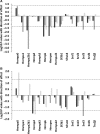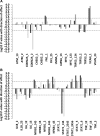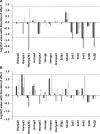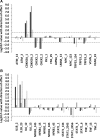Changes in the expression of splicing factor transcripts and variations in alternative splicing are associated with lifespan in mice and humans
- PMID: 27363602
- PMCID: PMC5013025
- DOI: 10.1111/acel.12499
Changes in the expression of splicing factor transcripts and variations in alternative splicing are associated with lifespan in mice and humans
Abstract
Dysregulation of splicing factor expression and altered alternative splicing are associated with aging in humans and other species, and also with replicative senescence in cultured cells. Here, we assess whether expression changes of key splicing regulator genes and consequent effects on alternative splicing are also associated with strain longevity in old and young mice, across 6 different mouse strains with varying lifespan (A/J, NOD.B10Sn-H2(b) /J, PWD.Phj, 129S1/SvlmJ, C57BL/6J and WSB/EiJ). Splicing factor expression and changes to alternative splicing were associated with strain lifespan in spleen and to a lesser extent in muscle. These changes mainly involved hnRNP splicing inhibitor transcripts with most changes more marked in spleens of young animals from long-lived strains. Changes in spleen isoform expression were suggestive of reduced cellular senescence and retained cellular proliferative capacity in long-lived strains. Changes in muscle isoform expression were consistent with reduced pro-inflammatory signalling in longer-lived strains. Two splicing regulators, HNRNPA1 and HNRNPA2B1, were also associated with parental longevity in humans, in the InCHIANTI aging study. Splicing factors may represent a driver, mediator or early marker of lifespan in mouse, as expression differences were present in the young animals of long-lived strains. Changes to alternative splicing patterns of key senescence genes in spleen and key remodelling genes in muscle suggest that correct regulation of alternative splicing may enhance lifespan in mice. Expression of some splicing factors in humans was also associated with parental longevity, suggesting that splicing regulation may also influence lifespan in humans.
Keywords: isoforms; lifespan; longevity; mRNA splicing; mouse; splicing factors.
© 2016 The Authors. Aging Cell published by the Anatomical Society and John Wiley & Sons Ltd.
Figures





Similar articles
-
Alternative splicing in aging and longevity.Hum Genet. 2020 Mar;139(3):357-369. doi: 10.1007/s00439-019-02094-6. Epub 2019 Dec 13. Hum Genet. 2020. PMID: 31834493 Free PMC article. Review.
-
Age-Related Alternative Splicing: Driver or Passenger in the Aging Process?Cells. 2023 Dec 12;12(24):2819. doi: 10.3390/cells12242819. Cells. 2023. PMID: 38132139 Free PMC article. Review.
-
Regulated splicing of the fibronectin EDA exon is essential for proper skin wound healing and normal lifespan.J Cell Biol. 2003 Jul 7;162(1):149-60. doi: 10.1083/jcb.200212079. J Cell Biol. 2003. PMID: 12847088 Free PMC article.
-
Dietary restriction in ILSXISS mice is associated with widespread changes in splicing regulatory factor expression levels.Exp Gerontol. 2019 Dec;128:110736. doi: 10.1016/j.exger.2019.110736. Epub 2019 Sep 12. Exp Gerontol. 2019. PMID: 31521722
-
Developmental and muscle-specific regulation of avian fast skeletal troponin T isoform expression by mRNA splicing.J Biol Chem. 1989 Jul 25;264(21):12482-91. J Biol Chem. 1989. PMID: 2745456
Cited by
-
MicroRNAs miR-203-3p, miR-664-3p and miR-708-5p are associated with median strain lifespan in mice.Sci Rep. 2017 Mar 17;7:44620. doi: 10.1038/srep44620. Sci Rep. 2017. PMID: 28304372 Free PMC article.
-
Negligible senescence in naked mole rats may be a consequence of well-maintained splicing regulation.Geroscience. 2020 Apr;42(2):633-651. doi: 10.1007/s11357-019-00150-7. Epub 2020 Jan 11. Geroscience. 2020. PMID: 31927681 Free PMC article.
-
Alternative mRNA Splicing in the Pathogenesis of Obesity.Int J Mol Sci. 2018 Feb 23;19(2):632. doi: 10.3390/ijms19020632. Int J Mol Sci. 2018. PMID: 29473878 Free PMC article. Review.
-
Deficiency of Splicing Factor 1 (SF1) Reduces Intestinal Polyp Incidence in ApcMin/+ Mice.Biology (Basel). 2020 Nov 13;9(11):398. doi: 10.3390/biology9110398. Biology (Basel). 2020. PMID: 33202710 Free PMC article.
-
The VEGFA156b isoform is dysregulated in senescent endothelial cells and may be associated with prevalent and incident coronary heart disease.Clin Sci (Lond). 2018 Feb 2;132(3):313-325. doi: 10.1042/CS20171556. Print 2018 Feb 14. Clin Sci (Lond). 2018. PMID: 29330351 Free PMC article.
References
-
- Almog N, Goldfinger N, Rotter V (2000) p53‐dependent apoptosis is regulated by a C‐terminally alternatively spliced form of murine p53. Oncogene 19, 3395–3403. - PubMed
-
- Barbosa‐Morais NL, Irimia M, Pan Q, Xiong HY, Gueroussov S, Lee LJ, Slobodeniuc V, Kutter C, Watt S, Colak R, Kim T, Misquitta‐Ali CM, Wilson MD, Kim PM, Odom DT, Frey BJ, Blencowe BJ (2012) The evolutionary landscape of alternative splicing in vertebrate species. Science 338, 1587–1593. - PubMed
Publication types
MeSH terms
Substances
Grants and funding
LinkOut - more resources
Full Text Sources
Other Literature Sources
Miscellaneous

